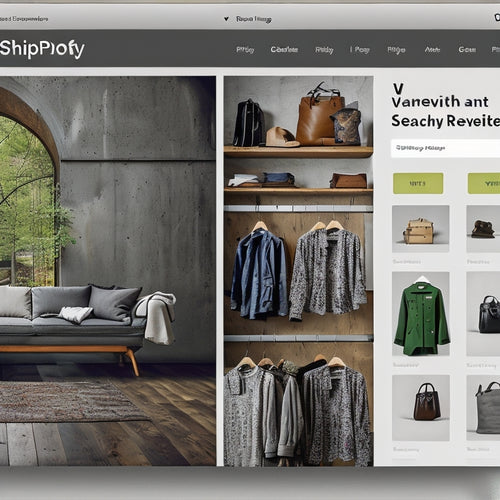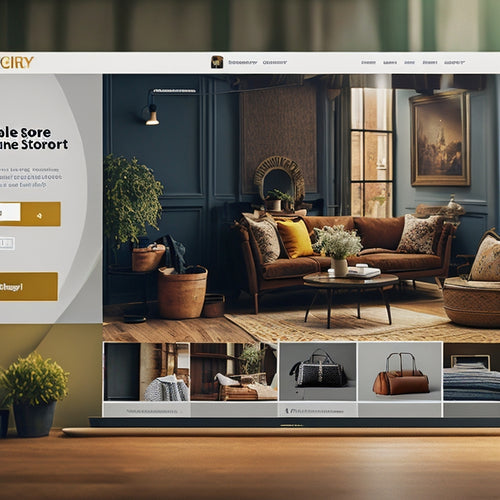
What Drives Customer Loyalty in Online Shopping?
Share
When shopping online, you prioritize convenience, personalized experiences, and seamless interactions. You expect brands to deliver a tailored experience that acknowledges your loyalty. Research shows that convenience greatly impacts overall satisfaction and return likelihood. Meeting your expectations is crucial for building loyalty, and understanding your needs helps foster a loyal customer base. Effective loyalty programs, personalized offers, and building trust and credibility are also key drivers. By incorporating these strategies, brands can increase engagement and retention. Dive deeper into the factors that drive customer loyalty, and you'll discover how to create a loyal customer base that will keep coming back.
Key Takeaways
• Convenience and personalized experiences drive customer loyalty in online shopping, leading to increased satisfaction and repeat business.
• Meeting customer expectations and understanding their needs are crucial for building a loyal customer base and encouraging repeat purchases.
• Effective loyalty programs with multiple tiers, points systems, and exclusive offers can foster engagement, retention, and loyalty among online shoppers.
• Personalization, exclusive offers, and tailored product recommendations can boost loyalty by making customers feel valued and appreciated.
• Building trust and credibility through authentic reviews, transparent customer service, and consistent brand messaging is essential for driving customer loyalty in online shopping.
Understanding Customer Expectations
As an online shopper, you're likely to develop loyalty to e-commerce platforms that consistently meet your evolving expectations, which are shaped by factors such as convenience, personalized experiences, and seamless interactions.
Frequently, online shoppers develop loyalty to e-commerce platforms that consistently meet their evolving expectations, which are shaped by factors such as convenience, personalized experiences, and seamless interactions.
To achieve customer satisfaction, e-commerce businesses must prioritize user experience by streamlining processes, reducing friction, and providing intuitive interfaces.
Convenience is key, as it directly impacts your overall satisfaction and likelihood of returning to the platform. By delivering exceptional user experiences, businesses can gain a competitive advantage over their rivals.
In today's digital landscape, meeting customer expectations is essential for building loyalty and driving repeat business. By understanding what drives customer satisfaction, businesses can tailor their strategies to meet your needs, fostering a loyal customer base that will propel their growth.
Effective Loyalty Program Strategies
You can increase your loyalty to an e-commerce platform by participating in well-designed loyalty programs that offer rewards, benefits, and personalized experiences tailored to your preferences and shopping habits. To create an effective loyalty program, e-commerce platforms should focus on implementing strategies that drive engagement and retention.
| Strategy | Description |
|---|---|
| Reward Tiers | Create multiple tiers with increasingly exclusive benefits, encouraging customers to climb the loyalty ladder. |
| Points System | Assign points for each purchase, redeemable for rewards or discounts, fostering a sense of accomplishment and loyalty. |
| Exclusive Access | Offer early access to new products, sales, or limited-edition items, making customers feel valued and part of an elite group. |
| Surprise and Delight | Surprise loyal customers with unexpected rewards or bonuses, creating a positive emotional connection with the brand. |
Personalization and Exclusive Offers
E-commerce platforms can further boost customer loyalty by incorporating personalization and exclusive offers that cater to individual preferences and shopping behaviors. You can leverage data and analytics to create customized recommendations that resonate with your customers' interests and needs.
For instance, you can use machine learning algorithms to suggest products based on browsing history, purchase behavior, and search queries. This tailored experience not only increases the chances of conversion but also fosters a sense of belonging and appreciation.
To take it a step further, you can offer limited discounts and members-only perks to make your customers feel valued and exclusive. This could include early access to new products, special promotions, or loyalty rewards. By creating a sense of FOMO (fear of missing out), you can encourage repeat purchases and drive customer loyalty.
Additionally, consider implementing a tiered loyalty program that rewards customers for their repeat purchases and referrals. By providing a personalized and exclusive experience, you can differentiate yourself from competitors and build a loyal customer base that drives long-term growth and revenue.
Building Trust and Credibility
How do online shoppers form lasting bonds with e-commerce platforms, and what factors contribute to building trust and credibility in the digital retail space? As you navigate the online shopping landscape, you're likely to encounter various elements that shape your perception of a brand.
Here are three key factors that contribute to building trust and credibility:
-
Authenticity through online reviews: When you read genuine reviews from fellow customers, you're more likely to trust the brand's claims. Online reviews provide social proof, helping you make informed purchasing decisions.
-
Transparent customer service: When you have a query or issue, prompt and helpful customer service can make all the difference. Brands that prioritize transparency and responsiveness build trust with their customers.
-
Consistent brand messaging: When a brand's message is consistent across all touchpoints, it conveys a sense of reliability and credibility. This helps you feel confident in your purchasing decisions and builds a foundation for long-term loyalty.
Measuring and Rewarding Loyalty
As you explore measuring and rewarding loyalty, you'll find that tracking customer interactions and purchases enables businesses to quantify loyalty and develop targeted strategies for rewarding and retaining their most valuable customers. This is where loyalty metrics come into play. By analyzing metrics such as repeat purchase rates, average order value, and customer lifetime value, you can identify areas of improvement and optimize your rewards systems.
To boost customer engagement, consider implementing tiered rewards systems that offer exclusive benefits to loyal customers. This could include early access to new products, exclusive discounts, or premium customer support. By recognizing and rewarding loyal customers, you can increase retention rates and drive long-term growth.
Effective retention strategies involve more than just offering discounts; they require a thorough understanding of customer behavior and preferences. By leveraging data and analytics, you can develop targeted loyalty programs that resonate with your customers and drive meaningful engagement.
Frequently Asked Questions
How Do I Balance Loyalty Initiatives With Other Marketing Strategies?
You'll need to prioritize loyalty initiatives by allocating resources effectively, ensuring loyalty rewards align with customer retention goals, and regularly measuring ROI to optimize your marketing strategy and maximize customer lifetime value.
Can Loyalty Programs Negatively Impact Profit Margins?
You're walking a thin tightrope: loyalty programs can be a double-edged sword, boosting customer satisfaction but potentially cannibalizing profit margins if not optimized for program effectiveness, highlighting the need for data-driven strategies to strike a balance.
What Role Does Employee Training Play in Customer Loyalty?
You invest in employee training to boost customer satisfaction, driving retention and ultimately, brand loyalty. Effective training correlates with a 25% increase in customer satisfaction, leading to a 15% increase in retention and a 10% rise in brand loyalty.
How Do I Handle Loyalty Program Data and Analytics?
You'll need to develop a data management plan, ensuring customer segmentation for personalized offers while prioritizing data privacy to maintain customer trust; investigate theories on data-driven loyalty programs to optimize your approach.
Are Loyalty Programs Only Effective for Frequent Buyers?
You may think loyalty programs only benefit frequent buyers, but they can also boost customer engagement with infrequent shoppers, increasing their repeat business by up to 20% with targeted, data-driven incentives.
Related Posts
-

Why and How to Create a Sitemap for Improved SEO
This article explores the significance of creating a sitemap for enhanced search engine optimization (SEO) and provi...
-

How Do I Customize My Search Results on Shopify
This article aims to provide an informative overview of the process of customizing search results on the Shopify pla...
-

Pros and Cons of Shopify for Online Businesses
This article provides an objective analysis of the pros and cons of using Shopify for online businesses. Shopify is ...


